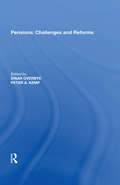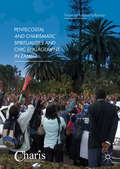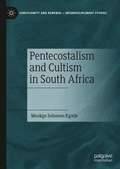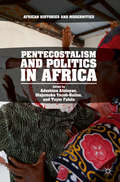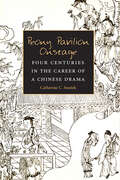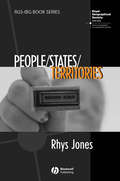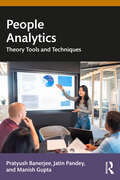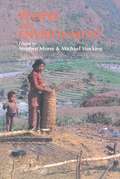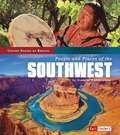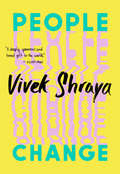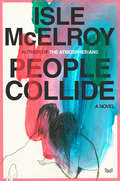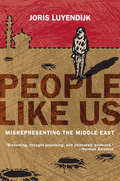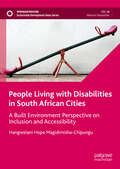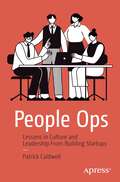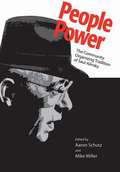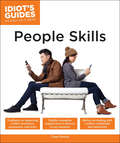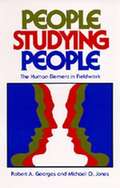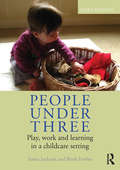- Table View
- List View
Pensions: Challenges And Reforms (International Studies On Social Security (fiss) Ser. #9)
by Einar OverbyeThroughout the developed world, public and private pension schemes face major challenges that are creating irresistible pressures for reform. Major structural changes in Latin America and in Central and Eastern Europe have led to particularly fierce pressure. Two member states of the European Union - Italy and Sweden - have introduced radical reform of their public pensions systems; controversial pension reforms have been proposed in France and Germany; and the British government has been widely criticized over its pension reforms and its 2002 white paper. This exceptional volume examines the challenges faced by pension schemes in the advanced economies and the reforms that have been introduced to tackle these challenges. A team of international contributors provides an up-to-date, invaluable analysis of different aspects of pension problems, prospects and reforms. The book incorporates cross-national chapters as well as a focus on individual countries including Belgium, Brazil, Colombia, Finland, Greece, Italy, Sweden, the UK and the USA.
Pentecostal and Charismatic Spiritualities and Civic Engagement in Zambia (Christianity and Renewal - Interdisciplinary Studies)
by Naar M’fundisi-HollowayFor the past sixty years, the Pentecostal and Charismatic movement has played a major role in Zambia. In this book, Naar Mfundisi-Holloway explains the history of this development and its impact on civic engagement. She opens a discussion on church-state relations and explains how the church presented a channel of hope in the wake of the HIV/AIDS pandemic, despite having a history that eschewed civic engagement. In fact, the pandemic propelled the church to work alongside the state in the fight against the disease. Using interviews and historical analysis, this book provides valuable insight into how Pentecostal and Charismatic churches have effectively engaged matters of civic concern in Zambia dating from colonial times.
Pentecostalism and Cultism in South Africa (Christianity and Renewal - Interdisciplinary Studies)
by Mookgo Solomon KgatlePentecostalism is a growing movement in world Christianity. However, the growth of Pentecostalism in South Africa has faced some challenges, including the abuse of religion by some prophets. This book first names these prophets and the churches they lead in South Africa, and then makes use of literary and media analysis to analyse the religious practices by the prophets in relation to cultism. Additionally, the book analyses the “celebrity cult” and how it helps promote the prophets in South Africa. The purpose of this book is threefold: First, to draw parallels between the abuse of religion and cultism. Second, to illustrate that it is cultic tendencies, including the celebrity cult, that has given rise to many prophets in South Africa. Last, to showcase that the challenge for many of these prophets is that the Pentecostal tradition is actually anti-cultism, and thus there is a need for them to rethink their cultic tendencies in order for them to be truly relevant in a South African context.
Pentecostalism and Politics in Africa (African Histories and Modernities)
by Toyin Falola Adeshina Afolayan Olajumoke Yacob-HalisoAs the epicenter of Christianity has shifted towards Africa in recent decades, Pentecostalism has emerged as a particularly vibrant presence on the continent. This collection of essays offers a groundbreaking study of the complex links between politics and African Pentecostalism. Situated at the intersection between the political, the postcolonial, and global neoliberal capitalism, contributors examine the roots of the Pentecostal movement’s extraordinary growth; how Pentecostalism intervenes in key social and political issues, such as citizenship, party politics, development challenges, and identity; and conversely, how politics in Africa modulate the Pentecostal movement. Pentecostalism and Politics in Africa offers a wide-ranging picture of a central dimension of postcolonial African life, opening up new directions for future research.
Peony Pavilion Onstage: Four Centuries in the Career of a Chinese Drama (Michigan Monographs In Chinese Studies #88)
by Catherine SwatekAfter its completion in 1598, The Peony Pavilion (Mudan ting) began a four-hundred-year course of transmission and dissemination in China and around the world. Within China, the play’s wide popularity propelled its appearance in numerous editions, adaptations, and libretti. Performances ranged from “pure singing” at private gatherings to full stagings in commercial theaters. As the crown jewel of Kun opera reportoire, Mudan ting has a richly documented history and lends itself to careful study. In the late twentieth century, however, classical Kun opera is on the verge of extinction in China, and creative talent is gravitating to centers outside China’s mainland. In 1998, the play was reintroduced to audiences in Europe and North America in various versions, adding new chapters to the story of the work. Peony Pavilion Onstage examines Tang Xianzu’s classic play from three distinct viewpoints: public-literati playwrights; professional performers of Kun opera; and quite recently, directors and audiences outside China. Catherine Swatek first examines two adaptations of the play by Tang's contemporaries, which point to the unconventionality of the original work. She goes on to explore how the play has been changed in later adaptations, up to its most recent productions by Peter Sellars and Chen Shi-Zheng in the United States and Europe. Peony Pavilion Onstage is essential reading for scholars and performers of this masterpiece and other great works of Chinese drama.
People - States - Territories: The Political Geographies of British State Transformation (RGS-IBG Book Series #92)
by Rhys JonesPeople/States/Territories examines the role of state personnel in shaping, and being shaped by, state organizations and territories, and demonstrates how agents have actively contributed to the reproduction and transformation of the British state over the long term. A valuable corrective to recent characterizations of territory as a static and given geographical concept An explication of the political geographies of state reproduction and transformation, through its focus on state territoriality and the variegated character of state power Considerable empirical insight into the consolidation of the British state over the long term.
People Analytics: Theory, Tools and Techniques
by Manish Gupta Pratyush Banerjee Jatin PandeyThis book addresses the topic of people analytics focusing especially on demystifying analytics for managers, from both statistical and computing points of view. It presents the evolution and the importance of people analytics in today’s workforce management and highlights the motivation for studying business analytics, shows the different levels of analytic maturity and discusses real world success stories of business analytics in action through case studies. The volume provides the readers with a step-by-step guide to analyze data and interpret the results for strategy formulation. Each chapter of the book includes a vignette, data-driven exercises provided in a companion website, and real-world case studies. The authors also introduce the readers to data visualization software Microsoft Power BI as well as elaborates on how to use Tableau Desktop.This book would be useful to the students of human resource management, organizational behaviour, marketing management, business research methods, applied psychology, social work and sociology. It would also serve as very good handbook for practicing business executives helping them to implement data analytics for effective decision making in all kinds of business situations around the world.
People And Environment: Development For The Future
by Stephen Morse Michael StockingFirst published in 1995. Routledge is an imprint of Taylor & Francis, an informa company.
People And Places Of The Southwest (United States By Region)
by Danielle Smith-LleraTake a trip to the Southwest! Each page is filled with exciting facts about this part of the United States, including its history, rich culture, geography, major cities, and everyday life. Buckle up as you read about and see pictures of this part of our fascinating country. Includes Arizona, New Mexico, Oklahoma, and Texas.
People Change
by Vivek Shraya"A deeply generous and honest gift to the world."--Elliot Page The author of I&’m Afraid of Men lets readers in on the secrets to a life of reinvention. Vivek Shraya knows this to be true: people change. We change our haircuts and our outfits and our minds. We change names, titles, labels. We attempt to blend in or to stand out. We outgrow relationships, we abandon dreams for new ones, we start fresh. We seize control of our stories. We make resolutions. In fact, nobody knows this better than Vivek, who&’s made a career of embracing many roles: artist, performer, musician, writer, model, teacher. In People Change, she reflects on the origins of this impulse, tracing it to childhood influences from Hinduism to Madonna. What emerges is a meditation on change itself: why we fear it, why we&’re drawn to it, what motivates us to change, and what traps us in place. At a time when we&’re especially contemplating who we want to be, this slim and stylish handbook is an essential companion—a guide to celebrating our many selves and the inspiration to discover who we&’ll become next.
People Collide: A Novel
by Isle McElroy“A big project knocking around in a small package, portending even bigger projects ahead.”—New York Times“A little Kafkaesque, a little Hitchcockian, a little Freaky Friday, but McElroy makes this dizzying story their own.”—Electric LiteratureFrom the acclaimed author of The Atmospherians, a gender-bending, body-switching novel that explores marriage, identity, and sex, and raises profound questions about the nature of true partnership.When Eli leaves the cramped Bulgarian apartment he shares with Elizabeth, his more organized and successful wife, he discovers that he now inhabits her body. Not only have he and his wife traded bodies, but Elizabeth, living as Eli, has disappeared without a trace. What follows is Eli’s search across Europe and to America for his missing wife—and a roving, no-holds-barred exploration of gender and embodied experience.As Eli comes closer to finding Elizabeth—while learning to exist in her body—he begins to wonder what effect this metamorphosis will have on their relationship and how long he can maintain the illusion of living as someone he isn’t. Will their new marriage wither completely? Or is this transformation the very thing Eli and Elizabeth need for their marriage to thrive?A rich, rewarding exploration of ambition and sacrifice, desire and loss, People Collide is a portrait of shared lives that shines a refreshing light on everything we thought we knew about love, sexuality, and the truth of who we are.
People Helping People: After Hurricane Katrina [Approaching Level, Grade 2]
by Barbara KanninenNIMAC-sourced textbook
People Helping People: After Hurricane Katrina [Beyond Level, Grade 2]
by Barbara KanninenNIMAC-sourced textbook
People Like Us: Misrepresenting the Middle East
by Joris LuyendijkIn People Like Us, which became a bestseller in Holland, Joris Luyendijk tells the story of his five years as a correspondent in the Middle East. Extremely young for a correspondent but fluent in Arabic, he spoke with stone throwers and terrorists, taxi drivers and professors, victims and aggressors, and all of their families. He chronicles first-hand experiences of dictatorship, occupation, terror, and war. His stories cast light on a number of major crises, from the Iraq War to the Israeli-Palestinian conflict, along with less-reported issues such as underage orphan trash-collectors in Cairo.The more he witnessed, the less he understood, and he became increasingly aware of the yawning gap between what he saw on the ground and what was later reported in the media. As a correspondent, he was privy to a multitude of narratives with conflicting implications, and he saw over and over again that the media favored the stories that would be sure to confirm the popularly held, oversimplified beliefs of westerners. In People Like Us, Luyendijk deploys powerful examples, leavened with humor, to demonstrate the ways in which the media gives us a filtered, altered, and manipulated image of reality in the Middle East.
People Like Us: What it Takes to Make it in Modern Britain
by Hashi MohamedHashi Mohamed came to Britain aged nine, a refugee from the Somali civil war. He attended some of Britain's worst schools and was raised exclusively on state benefits. Yet today he is a successful barrister, with an Oxford degree and a CV that includes appearances on the BBC.In People Like Us, Hashi explores what his own experience can tell us about social mobility in Britain today. Far from showing that anything is possible, he concludes his story is far from typical: our country is still riven with deep divisions that block children from deprived backgrounds from accessing the advantages that are handed to others from birth.Confronting the stark statistics that reveal the depth of the problem, the problems of imagination and confidence that compound it, and offering inspirational advice for those hoping to change their own circumstances, People Like Us is essential reading for anyone who wants to understand modern Britain - and how we could change it for the better.
People Living with Disabilities in South African Cities: A Built Environment Perspective on Inclusion and Accessibility (Sustainable Development Goals Series)
by Hangwelani Hope Magidimisha-ChipunguThis book offers a unique and much-needed perspective on disability and accessibility in urban context in South Africa. Drawing on lived experiences of disabled people, it documents the multidimensional aspect of poverty in the context of disability and built environment to show how poorly planned cities create physical and social barriers that impact the life of people with disabilities. People Living with Disabilities in South African Cities is structured around three main insights and themes that inform the author's approach to disability and cities. The first is disability research; drawing on studies on planning and the built environment, the author highlights the role of physical environment in promoting inclusion and accessibility for people with disabilities. The second theme is social protection, i.e. ways to provide support and resources for people with disabilities to enable them to participate fully in society. Finally, the author explores the policies and legislative context needed to create an inclusive society, challenging the role of governments and policy makers. Offering a comprehensive approach to studying disabilities and cities, the author aims to bridge the gap between disability studies, inclusive planning, and design to support the development of accessible cities in the African context. This invaluable book not only raises awareness on social inclusion, but also offers an invaluable guide to policy makers across the Global South to tackle and address inequalities.
People Love Dead Jews: Reports From A Haunted Present
by Dara HornA startling and profound exploration of how Jewish history is exploited to comfort the living. Renowned and beloved as a prizewinning novelist, Dara Horn has also been publishing penetrating essays since she was a teenager. Often asked by major publications to write on subjects related to Jewish culture—and increasingly in response to a recent wave of deadly antisemitic attacks—Horn was troubled to realize what all of these assignments had in common: she was being asked to write about dead Jews, never about living ones. In these essays, Horn reflects on subjects as far-flung as the international veneration of Anne Frank, the mythology that Jewish family names were changed at Ellis Island, the blockbuster traveling exhibition Auschwitz, the marketing of the Jewish history of Harbin, China, and the little-known life of the "righteous Gentile" Varian Fry. Throughout, she challenges us to confront the reasons why there might be so much fascination with Jewish deaths, and so little respect for Jewish lives unfolding in the present. Horn draws upon her travels, her research, and also her own family life—trying to explain Shakespeare’s Shylock to a curious ten-year-old, her anger when swastikas are drawn on desks in her children’s school, the profound perspective offered by traditional religious practice and study—to assert the vitality, complexity, and depth of Jewish life against an antisemitism that, far from being disarmed by the mantra of "Never forget," is on the rise. As Horn explores the (not so) shocking attacks on the American Jewish community in recent years, she reveals the subtler dehumanization built into the public piety that surrounds the Jewish past—making the radical argument that the benign reverence we give to past horrors is itself a profound affront to human dignity.
People Ops: Lessons in Culture and Leadership From Building Startups
by Patrick CaldwellLearn how to deal with difficult employee demands, what candidates actually think about recruitment processes, how to navigate layoffs, address the gender pay gap, and protect your time and wellbeing. People Ops is a collection of candid lessons, stories, and principles in leadership, people, and culture from startup environments. It reveals the hard truths and sometimes uncomfortable realities that we all know exist but struggle to articulate.For decades, business and HR leaders have struggled to navigate the complexities of managing people and teams within startups and scaling companies, instead relying on the broad rhetoric of management theory to tackle these challenges or leaning on their networks of leaders who have encountered these challenges before. In parallel, the HR industry has been undergoing a transformation with the growth of People Operations. It’s a distinct field in HR that relentlessly focuses on engagement, culture, automation and putting people at the heart of all business operations. At the intersection of startups and people operations is an increasingly ambiguous business challenge for how startups can apply leading people practices to drive their growth, rather than in spite of their growth.People Ops is a tactical companion for business and People Operations leaders designed to support them in their roles, spark inspiration and challenge conventional thinking. It supplements author Patrick Caldwell's own experience across multiple startups with stories and examples from his network of investors, CEOs, Founders and C-Level HR executives.What You'll LearnLessons from a path walked building People Operations in a startup environmentUncomfortable truths around the complexities of managing people The key components of a People Operations strategy within a small businessWho This Book is ForThose in small-medium sized businesses, especially startups, where the reader is in a position of responsibility for people and culture. They’ll likely hold business leadership positions such as Founder, CEO, COO, VP and Director, or they’ll be directly within the HR and People Operations space with titles such as CHRO/CPO, Head, Director, Business Partner or Advisor
People Power: The Community Organizing Tradition of Saul Alinsky
by Aaron Schutz Mike MillerSaul Alinsky, according to Time Magazine in 1970, was a "prophet of power to the people," someone who "has possibly antagonized more people . . . than any other living American." People Power introduces the major organizers who adopted and modified Alinsky's vision across the United States:--Fred Ross, Cesar Chavez, Dolores Huerta, and the Community Service Organization and National Farm Workers Association--Nicholas von Hoffman and the Woodlawn Organization--Tom Gaudette and the Northwest Community Organization--Ed Chambers, Richard Harmon, and the Industrial Areas Foundation--Shel Trapp, Gale Cincotta, and National People's Action--Heather Booth, Midwest Academy, and Citizen Action--Wade Rathke and ACORNWeaving classic texts with interviews and their own context-setting commentaries, the editors of People Power provide the first comprehensive history of Alinsky-based organizing in the tumultuous period from 1955 to 1980, when the key organizing groups in the United States took form. Many of these selections--previously available only on untranscribed audiotapes or in difficult-to-read mimeograph or Xerox formats--appear in print here for the first time.
People Power: The Community Organizing Tradition of Saul Alinsky
by Aaron Schutz and Mike MillerSaul Alinsky, according to Time Magazine in 1970, was a "prophet of power to the people," someone who "has possibly antagonized more people . . . than any other living American." People Power introduces the major organizers who adopted and modified Alinsky's vision across the United States: --Fred Ross, Cesar Chavez, Dolores Huerta, and the Community Service Organization and National Farm Workers Association --Nicholas von Hoffman and the Woodlawn Organization --Tom Gaudette and the Northwest Community Organization --Ed Chambers, Richard Harmon, and the Industrial Areas Foundation --Shel Trapp, Gale Cincotta, and National People's Action --Heather Booth, Midwest Academy, and Citizen Action --Wade Rathke and ACORN Weaving classic texts with interviews and their own context-setting commentaries, the editors of People Power provide the first comprehensive history of Alinsky-based organizing in the tumultuous period from 1955 to 1980, when the key organizing groups in the United States took form. Many of these selections--previously available only on untranscribed audiotapes or in difficult-to-read mimeograph or Xerox formats--appear in print here for the first time.
People Reading: Control Others
by BeierEvery time we talk with people we are trying to influence their behavior, and they are trying to influence ours. The words we use, the way we dress and move, are all ways to seek to control one another. Though we may make these attempts unknowingly, they leave us open to dangerous manipulation. People-Reading will teach you how to listen and what to look for in yourself and those around you, so you can identify underlying hidden motives, expectations, and fears. By reading these hidden messages you can avoid their damaging effects.
People Skills: Helpful Guidance on Interacting in Any Situation (Idiot's Guides)
by Casey HawleyPeople skills — also known as interpersonal skills — are key to succeeding in work and in life. Many people struggle with these specific skills, particularly in an increasingly digital world. Idiot's Guides: People Skills offers expert advice on the foundations of effective communication, tips on understanding and maximizing nonverbal communication, ways to handle conflict and difficult conversations, pointers on being more influential and persuasive, and a primer for public speaking to small or large groups.
People Studying People
by Robert A. Georges Michael O. JonesThe authors of this book demonstrate that fieldwork is first and foremost a human pursuit. They draw upon published and unpublished accounts of fieldworkers' personal experiences to develop the thesis that an appreciation of fieldwork as a unique mode of inquiry depends upon an understanding of the role the human element plays in it. They analyze the processes involved when people study people firsthand, focusing upon the recurrent human problems that arise and must be solved. The human processes and problems, they argue, are common to all fieldwork, regardless of the disciplinary backgrounds or the specific interests of individual researchers.
People Together: Adventures in Time and Space
by James A. Banks Barry K. Beyer Gloria Contreras Jean Craven [et al.]A social studies book equipped with a handbook to guide the readers through the various ways on how to read and understand social studies.
People Under Three: Play, work and learning in a childcare setting
by Sonia Jackson Ruth ForbesServices for young children have gone through a period of rapid transformation in recent years, which have been paralleled by great advances in our knowledge of early child development. However, care and education in the first three years of life continues to be a neglected area. Thoroughly updated to take account of key policy and practice changes in childcare provision, this landmark text translates child development theory and research into everyday practice. All the practical ideas in the book have been developed and tested in nurseries, family and children’s centres and include the importance of providing opportunities for adventurous and exploratory play for babies and toddlers, understanding and responding to children's emotional needs and offering personalized and sensitive care. The book also explores different ways of working with parents and the role of early years settings and practitioners in helping to keep children safe. It includes chapters on: Childcare policy and services Planning spaces for living, learning and playing Babies in day care Heuristic play with objects Mealtimes Learning out of doors Leading and managing a childcare centre Involving and working with parents Safeguarding children People Under Three is an established practical text for all those training to work with young children or managing day care facilities. Focusing on the care and learning of very young children, it is designed specifically for those who look after them day by day, as well as being a useful resource for social work students and policy makers.
